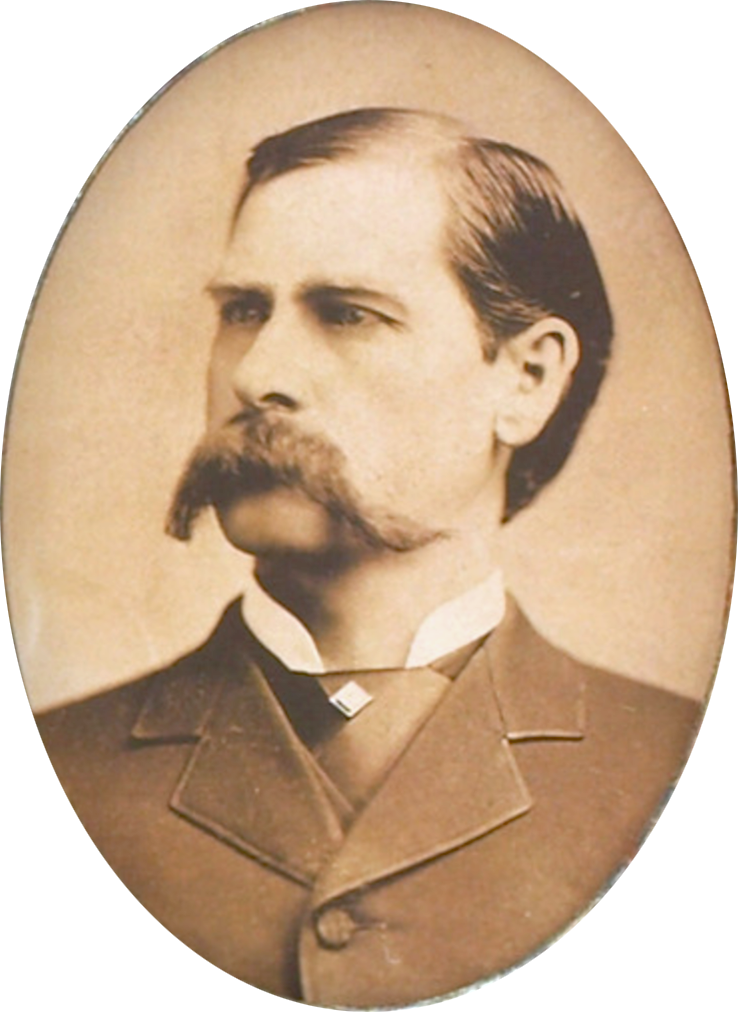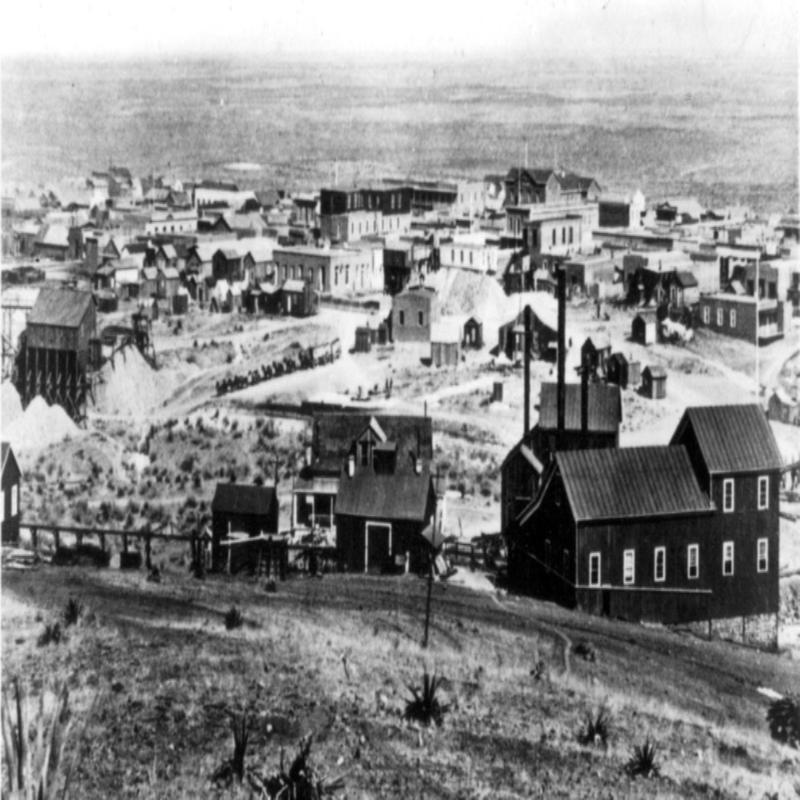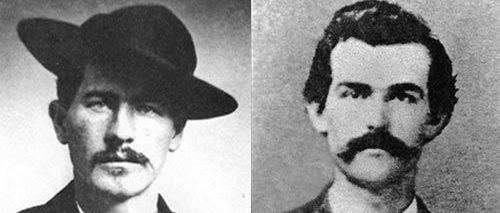Doc Holliday: The Deadly Dentist
Posted on 7th May 2021
Few more legendary figures emerged from the American West than Doc Holliday, the bucolic, sociopathic gambler, gunfighter and friend of Wyatt Earp.
John Henry “Doc” Holliday was born in the town of Griffin, Georgia, on 14 August 1851. His father, Henry Burroughs Holliday had made his fortune in cotton in the ante-bellum south before serving as a Major in the Confederate Army during the Civil War.
Both parents doted on the young John Henry and his mother Alice in particular spent considerable time helping him overcome a speech impediment that was the result of corrective surgery for a cleft palette and the many hours they spent together saw John become particularly close to his mother who though she could not cure him entirely of his lisp was to teach him the etiquette and manners that were to define his personality if not his character, for the rest of his life. When she died in 1866, having endured tuberculosis for many years, the same disease inherited in the womb that would blight his own life, he was devastated.

Despite the premature death of his mother, John’s early life had been a stable and happy one and he was described as an amiable, well-spoken and polite young man though early on he displayed a fiery temper. On one occasion taking exception to some black men who were bathing in the same part of the river that he liked to use himself he took out the gun he had been taught to use by his father and fired upon them. The men fired back, and a gunfight ensued but, on this occasion, at least, no one was hurt.
John was educated at the Valdosta Institute in Georgia where he learned grammar, rhetoric, mathematics and history. He also became fluent in French, could speak Latin and Ancient Greek and could play the piano passably well. By the time he completed his studies he was every inch the polished Southern gentleman.
In 1870, he left Georgia to study dentistry in Philadelphia where he graduated in March 1872 but by this time ashen-faced, hollow-eyed and pitifully thin he had already been diagnosed with consumption as it was then known, and the verdict was not a good one. He was given just a few months to live. In response to the diagnosis, he decided to move to Texas where it was thought that the drier climate would help improve his health.
In September 1873, he settled in Dallas where he opened a dental surgery, but it wasn’t a success since people stopped using it once they found out about his condition and already a heavy drinker in the local saloons he soon found gambling a more lucrative and less taxing source of income than his chosen profession.
With an innate volatility of character, he always seemed to be involved in some dispute or other and after several incidents including being arrested on suspicion of murder he quit Texas as much out of concern for his future freedom as for his health.
By now often intoxicated he travelled from place to place making a living as a gambler and faro dealer and becoming a familiar face in towns such as Denver and Deadwood where having let it be known that he preferred a violent death to meekly succumbing to illness he soon acquired a reputation as a man to be avoided.

Around this time, he also met Katharine Horony, or “Big Nose Kate” as she was known who would be both his lover and his accomplice for much of the rest of his life.
She was the daughter of an eminent Hungarian doctor who had emigrated to America in 1860 when she was aged ten but what had seemed a bright future turned sour just two years later when her parents died in a yellow fever epidemic and she along with her siblings were placed in a children’s home.
Five years later Kate, a stubborn and wilful character who was to retain her strong Hungarian accent fled the home and headed West where she worked as a prostitute and ran a series of boarding houses or bordellos. In an often-fractious relationship Kate was to prove not only the intellectual equal of Doc but shared his fiery temper and could match his prodigious drinking. They rowed often sometimes in public, occasionally it spilled onto the street, and it frequently turned violent. Few were unaware when Doc and his “Hungarian Devil” were in town.

In 1878, while residing in Dodge City and always up for a scrap, he intervened in a fight on behalf of Wyatt Earp whom he had previously met in Tucson. Wyatt was later to credit Doc with saving his life.
Soon after the incident in Dodge City, Doc knifed a fellow gambler Ed Bailey, to death in a fight over a disputed card game but no action was taken as it was deemed to be self-defence even though it was well-known that Doc had previously been involved in a number of similar incidents. In July 1879, he was arrested for shooting dead a U.S Army Scout Mike Gibson in a gunfight but was acquitted after no witnesses could be found willing to testify against him.
By now nearly always drunk to some degree or other he was a man quick to pick a fight and even quicker on the draw, but he wasn’t always accurate, and there were any number of innocent bystanders wounded in gunfights involving Doc Holliday.
Deeply unpopular though he was Doc’s courtly southern manner and softly spoken tones could often attract even if those initially seduced would think otherwise just a few hours later. There were few who met Doc who had a good word to say for him, but he had one quality that was admired and especially by Wyatt Earp – loyalty.

In September 1880, he moved on to Tombstone, Arizona, probably at the request of the Earp’s who were expecting trouble from the Cowboy faction in town, particularly the Clanton’s and McLaury’s.
Wyatt’s brothers were not best pleased at the invitation, and he had to constantly remind them of Doc’s qualities which were not always evident to the naked eye. He would be a devoted friend and ally, he said, if not a loving or affectionate one.
Holliday, disputatious by nature, soon found himself embroiled in local politics and on the night before the famous incident at the O.K Corral drunk and dishevelled he confronted Ike Clanton who was eating in a local saloon. He proceeded to berate Ike in the most abusive terms in an attempt to goad him into going for his gun as people fled the saloon fearing the worse; he even threatened to shoot him there and then if he didn’t draw but Ike stayed calm and didn’t to rise to the bait. A furious and disgruntled Holliday eventually left the saloon threatening all kinds of dire consequences on the morrow.
Holliday and the Clanton’s had history, in August 1880, Doc had been implicated in an ambush that had killed Ike’s father and four other Cowboy’s and it was said that the walking stick he now used was as the result of the wounds he sustained in the gunfight.

Believing that the Clanton’s and McLaury’s were in town to kill them, the Town Marshal Virgil Earp determined to act first so along with his brothers Wyatt and Morgan and joined by Doc, they cornered the Clanton’s and McLaury’s in the O.K Corral late in the afternoon of 26 October 1881.
It seems likely that Virgil only intended to detain the Clanton’s and McLaury’s who had infringed a town ordinance banning the carrying of firearms within its precincts but the tension that had built up over the previous months had guaranteed that this wasn’t going to end peacefully and as the two groups eye-balled one another the tension simply became unbearable.

Doc, who was carrying a shotgun that had been given to him by Morgan Earp and which he could easily conceal under his long coat provoked the confrontation by remonstrating with one of the McLaury’s before pushing him violently in the chest, soon after Wyatt and Frank McLaury drew on one another firing almost simultaneously. They both missed at short range, but Doc didn’t, shooting Frank McLaury dead.
Both sides now began shooting wildly at each other in a furious exchange of gunfire that was to result in the deaths of Tom and McLaury,and seventeen year old Billy Clanton. All the Earp’s and Doc had been wounded.
One of the most legendary incidents in the history of the American West had lasted barely a minute, though it was seen at the time as just another violent shoot-out among many.
The Earp’s were subsequently put on trial for murder but despite Ike Clanton providing an eye-witness account and testifying against them they were acquitted on all charges. Events did not end there however, and the Cowboys would have their revenge when in December 1881, Virgil Earp was shot and maimed for life losing the use of his right arm. The following March, Morgan Earp was shot in the back and killed. The remaining Earp’s fled Tombstone, but Wyatt would be back.
Determined to avenge himself on those who had shot his brothers and dishonoured his family Wyatt quickly identified those who were responsible for the attacks and gathering some friends around him among whom were Sherman McMasters, “Turkey Creek Jack” Johnson, “Texas Jack” Vermillion, his younger brother Warren and of course Doc Holliday, they now embarked upon a three-week orgy of violence that was to become known as ‘Wyatt’s Revenge Ride.’ In that time at least 8 Cowboys were killed, though the actual figure may have been much higher.
The first to die on 20 March 1882 was Frank Stilwell, who unarmed had been killed in cold blood. It is not known for certain whether it was Doc or Wyatt who was responsible. Four days later in a ferocious shoot-out at Iron Springs, Wyatt Earp gunned down the Cowboys erstwhile leader “Curly Bill” Brocius whom he held personally responsible for the murder of his brother, Morgan. The death of “Curly Bill” effectively broke the power of the Cowboys, but the killing did not end there. In July 1882, the legendary Johnny Ringo was shot dead in Tombstone.
He and Doc had been old enemies who’d had many altercations in the past. Indeed, Doc had been overheard telling Ringo: “All I want from you is ten paces out in the street.” Rumours persist that Johnny Ringo’s murder was Wyatt’s reward to Doc for his loyalty.
With their thirst for revenge sated, Doc who could only ever be an ally never a friend and Wyatt went their separate ways. Doc travelled to Colorado where his health went into rapid and irreversible decline, and he became reliant upon large doses of laudanum and alcohol just to see him through the day. Finally, he settled in Glenwood hoping the waters there would help clear his lungs, but he was by now dying and despite his best endeavours to do otherwise he would die in his bed.
Committed to a nursing home he spent the last months of his life bed-ridden and slipping in and out of consciousness. Having received absolution for his sins on 8 November 1887, he died aged 36. His last recorded words, “I’ll be damned. This is funny.” His tombstone reads: “Doc Holliday 1852 – 1887. He died in his bed.” Whether he rests easy or not remains another matter.
Wyatt Earp was later to write of his friend:
“Doc was a dentist not a lawman, or an assassin, whom necessity had made a gambler, a gentleman whom disease had made a frontier vagabond, a philosopher whom life had made a caustic wit. A long, lean, ash-blond fellow nearly dead with consumption, and at the same time the most skilful gambler and the nerviest, speediest, deadliest man with a gun I ever knew.”
Once asked if he ever had a conscience about killing, Doc replied: “I coughed all that up with my lungs years ago.”
Tagged as: Miscellaneous
Share this post:





